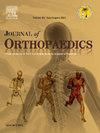Psychological readiness of return to sport after arthroscopic Bankart repair: A systematic review
IF 1.5
Q3 ORTHOPEDICS
引用次数: 0
Abstract
Introduction
Surveys such as the Shoulder Instability-Return to Sport after Injury (SIRSI) scores can help identify athletes who are better prepared to return to sport (RTS) after arthroscopic Bankart repair (ABR). Therefore, the purpose of this systematic review was to clarify how psychologically ready athletes are to RTS after ABR, with the secondary purpose of evaluating the impact of psychological readiness on athletes’ ability to RTSS after ABR.
Methods
The Ovid Medline, PubMed, and SportDiscus databases were searched from inception until January 2023 using keywords such as Bankart, anterior labral repair, shoulder stabilization, return to play, and return to sport. Original studies were included if both RTS outcomes after ABR and a psychological factor were reported, with potential psychological factors being psychological readiness to RTS and reasons of failing to RTS.
Results
Overall, 707 studies were screened and 16 met criteria for inclusion. The mean MINORS score of included studies was 13.3 ± 4.1. In patients who failed to RTS, most (74 %) patients failed due to recurrent shoulder instability, pain, or injury, while 26 % reported failing to RTS due to non-shoulder related causes such as apprehension and fear of reinjury. Eight studies evaluated post-operative SIRSI scores with a mean of 65.4 (95 % CI: 62.9–72.8) at an average of 5.4 years post-operatively.
Conclusion
Most athletes fail to RTS due to shoulder-related causes, with apprehension and fear of reinjury as common causes as shoulder-independent causes for failed RTS. The mean SIRSI score after ABR was 65.4, and athletes with higher post-operative SIRSI scores were more likely to RTS.
Level of evidence
IV.
求助全文
约1分钟内获得全文
求助全文
来源期刊

Journal of orthopaedics
ORTHOPEDICS-
CiteScore
3.50
自引率
6.70%
发文量
202
审稿时长
56 days
期刊介绍:
Journal of Orthopaedics aims to be a leading journal in orthopaedics and contribute towards the improvement of quality of orthopedic health care. The journal publishes original research work and review articles related to different aspects of orthopaedics including Arthroplasty, Arthroscopy, Sports Medicine, Trauma, Spine and Spinal deformities, Pediatric orthopaedics, limb reconstruction procedures, hand surgery, and orthopaedic oncology. It also publishes articles on continuing education, health-related information, case reports and letters to the editor. It is requested to note that the journal has an international readership and all submissions should be aimed at specifying something about the setting in which the work was conducted. Authors must also provide any specific reasons for the research and also provide an elaborate description of the results.
 求助内容:
求助内容: 应助结果提醒方式:
应助结果提醒方式:


